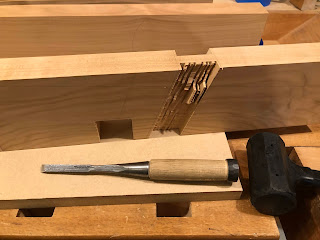I wrote about this back in 2016. There has been quite a gap (5 years) and a few twists and turns along the way. But here I am, back at it! Thanks Covid for giving me all this shop time.
March 21 2013. It started on a beautiful sunny early spring morning. A couple of local cherry street trees had been cut down and found their way down to the city log dump where a friendly city worker set them up for me to slab with my Alaska mill.
After a few years of being stacked at the side of my house to dry, in 2016 they went through my little home made dehumidifier kiln to squeeze out the last few percent of moisture.
Then it was time to run the slabs through my large planer. I glued each slab to a torsion box, supported the high spots with wedges that were also glued, then cleaned up the slabs.
A lot of chips were generated, my cyclone was great but the chip container was way too small!
The slabs were pretty nice, I was happy with them. My planer had a ton of snipe though.
I cut the slabs up into sticks, let them dry, then cleaned them up further. I wound up with about ten. Some grain straightening was required.
My plan was to use them for the base of a coffee table, similar to this George Nakashima table.
The piece on the bottom, what I call the "spine", I did not have anything long enough. I decided to join two pieces together end to end using a rabbeted oblique scarf splice joint, AKA "okkake doisen tsugi".
I thought it would be wise to do a test of this joint. Good thing I did, I wound up with a bad gap.And also a crack.
So then I marked up my real pieces and I made the cuts. But I made a terrible mistake. Can you see it?
I would have needed to cut the entire joint off and start again. But the pieces were not long enough to allow that. So this project was dead dead dead. After that disaster I decided to give the wood a detention so I took it into a spare room in my house and let it sit there for five years.
By then I had commiserated with some woodworking buddies and received a very excellent suggestion (thank you Jaime and Kenji!!) on how to fix it. I glued and screwed on a couple pieces of dark wood to
make up for my mistake! The screws will not be visible when the joint is closed.
I used a piece of holly to close up the joint. The gap in this joint was also pretty bad unfortunately. Apparently any lessons from five years ago had been forgotten. Meh. I got on with it.
Once the spine was built, I thought I should do a mock up of some of the cuts that would be needed in it. I did one "leg" and one "arm" and "hand". After looking at it I decided to make the arm angle a
smidge steeper.
Arm and Hand
So I took the real spine to my tablesaw and after about two weeks of careful contemplation, made the necessary cuts. It seems I was mistake-free this time. So far at least.
My saw cuts at 90 degrees only, so I had to make up a little jig with some MDF in order to cut the angles for the bridal joints for the arms.
I use a flat-top saw blade so I get a nice even depth groove. But I noticed that one side of the saw blade cuts much more smoothly than the other. Time for a resharpening! But it doesn't matter in this case as I will be sneaking up on the final fit by hand so the rough cut will be trimmed off anyways.
Once I cut some grooves on the tablesaw I use a chisel to cut out the bulk of the waste, then I went back to the tablesaw to clean up the bottom. Next will be the fitting of the legs and arms to this spine piece.
In parallel with this flurry of activity I have also been trying to decide on what to use for the top. Once I get everything fitted to the spine I will not be able to put the top decision off any further. The dimensions of the top will to some extent dictate the dimensions of the legs and hands. But I have narrowed the top down to two choices so it should not be that hard to decide.
This is my goal.
So that is an update on where I am now. Hopefully I will continue to make progress in the coming weeks.




















































